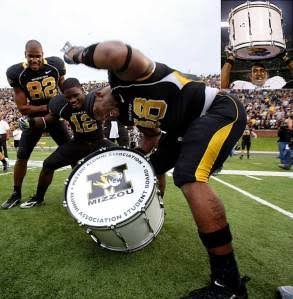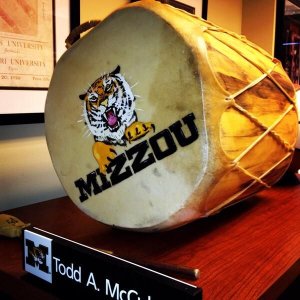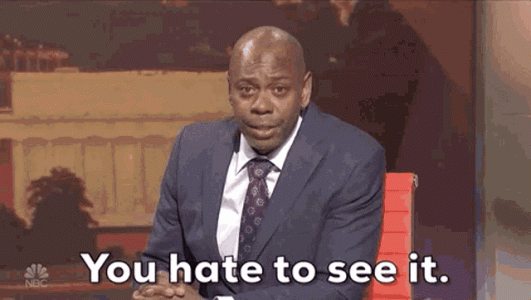TrueOrange
Well-Known Member
- Joined
- Jul 7, 2008
- Messages
- 52,447
- Likes
- 7,604
After a 14-year hiatus, one of college football’s most historic rivalries has returned. It’s the oldest Division I rivalry west of the Mississippi River: The Border War. a rivalry steeped in hatred, pageantry, and even a violent state history preceding and continued through the Civil War.
Each school’s team gets their name from the states’ extremely violent, pre-Civil War “Bleeding Kansas” and Civil War periods. It’s a very dark period. The “Bleeding Kansas” decade of open violence (between the pro and anti-slavery elements of the Kansas Territory and western frontier towns of Missouri) erupted into very vicious fighting once the actual Civil War began. Kansas takes its team name from the “Jayhawkers”, free-state vigilante forces that often attacked, plundered, and burned multiple Missouri towns and large swaths of western section of the state.
…The retaliation for the was…severe. William Quantrill’s bushwhacker group, Quantrill’s Raiders, went into Lawrence and just, well, destroyed everything. Over four hours, a quarter of the buildings in the city were pillaged and burned, most of the stores and banks were looted, and over 150 people (all men and boys) were killed…it was less of a raid and more of a mass execution.
—Meanwhile, Missouri takes its team name from “The Tigers”, a militia unit during the Civil War that maintained and protected Columbia from multitudes of guerrilla attacks and raids coming out of Kansas as well as the East.
(Seriously…everyone in the North and South likes to think of the Civil War in as this organized, respectful, “war’s an adventure” historical event, but the Missouri/Kansas area was something worse. If you ever read up on the specific area, journals from the soldiers reach this point of like - after 15 years of this - just seeing the other side as soulless and insisting they deserved death, pain, dismemberment and more because of who they are…it gets really f—-ing dark.)
The rivalry’s early years also saw Civil War Veterans occupying both sidelines watching the game.
But back to the on-the-field game itself:
First meeting on Halloween 1891, only two things ever stopped these two schools from playing: the 1918 Spanish Flu pandemic and conference realignment. When the series ended in 2011 following Missouri’s move to the SEC, it was the 2nd most played game in FBS history, with 120 meetings in 121 years (93 straight following the one interruptions…had it continued it’d be sitting around 134 games). Although Missouri extended a hand to continue the rivalry in 2012, Kansas - following Texas’s lead with A&M when the latter left the Big 12 - spit on it and refused to do so…until now. Still, even with the 14 year hiatus, it still currently sits at the 12th most played FBS rivalry, now tied with the Bluebonnet Battle (TCU-Baylor), Tennessee-Kentucky, and the Red River Rivalry.
Historically the traditional game to end the regular season game for each team, Kansas won the very first matchup 22-10, however Missouri leads the overall series record. There’s a bit of dispute in the series record (due to the 1960 Kansas forfeiture due to ineligibility, more on that later): according to the Tigers Missouri leads the series 57-54-9, while the Jayhawks claim Missouri leads the series 56-55-9.
Even the coaches got deep into the rivalry as time went on. Former Kansas coach, Don Famborough, when referred to a physician across the state border in Missouri, retorted "I'll die first!". Former Missouri coach Norm Stewart - when having to play away games in Lawrence - had the players stay in the Missouri side of Kansas City and travel the day of the game, require the team bus buy gasoline only in Missouri, reprimand players who ate in Kansas, and do just about anything to not put additional money into Kansas’s economy. Another Kansas football coach (his name escapes me) once said “Kansas State is our rival. Missouri is our enemy.”
The rivalry also holds an esteemed honor as the 1911 game was the birthplace of Homecoming, a 3-3 tie in front of 10,000 or so gathered in the stadium. However, in Lawrence, Kansas, over 1,000 people also gathered downtown for unique mechanical coverage of the game. While the game was played on the field, a Western Union telegraph wire set up directly from Columbia was used to “broadcast” the game to the gathered Lawrence crowd. As telegraph messages came in, a group of people would announce the results of the previous play, using a large model of a football playing field to then show the results of each play while those in attendance cheered and chanted as though watching the game live.
The 2007 season even saw a de facto “#1 vs #2” game. After #1 LSU lost the day before to Arkansas, #3 10-1 Missouri beat #2 11-0 Kansas 36-28 in Arrowhead Stadium in front of 80,537 people, the second-largest attendance at Arrowhead to this day. (The game also was flexed into an ABC night game, drawing the largest TV audience of any 2007 regular season game.)
Then there’s also the 1960 game. How to put this? Imagine if, in say the 1930s, Tennessee went 9-0, was ranked #1 in the polls, but then lost the last game of the season to Kentucky/Ole Miss/Auburn/whichever finale team. Then within the next week, it came out that one of the main starters - the main offensive weapon, a running back who scored all the TDs in that upset, who had been under investigation all season over eligibility, who had actually been ruled ineligible mid-season but the team kept pushing back against the NCAA and the conference and kept playing him until they couldn’t any more - was ultimately completely ineligible, should never have seen the field, and the conference forced the team to forfeit all its wins within the week…but with the final polls being released at regular season’s end, the damage was already done, and Tennessee falls from #1 to #5, missing out on a national title it probably should have had, even after winning the Sugar Bowl against the #4 team. Well, that’s the 1960 Missouri-Kansas game (just swap in Missouri for Tennessee, Kansas for the final appointment, and Orange Bowl for Sugar Bowl).
While it’s not Iron Bowl or The Game by a long shot, it’s definitely one of those rivalries where college football is better when they’re playing each other.
Each school’s team gets their name from the states’ extremely violent, pre-Civil War “Bleeding Kansas” and Civil War periods. It’s a very dark period. The “Bleeding Kansas” decade of open violence (between the pro and anti-slavery elements of the Kansas Territory and western frontier towns of Missouri) erupted into very vicious fighting once the actual Civil War began. Kansas takes its team name from the “Jayhawkers”, free-state vigilante forces that often attacked, plundered, and burned multiple Missouri towns and large swaths of western section of the state.
…The retaliation for the was…severe. William Quantrill’s bushwhacker group, Quantrill’s Raiders, went into Lawrence and just, well, destroyed everything. Over four hours, a quarter of the buildings in the city were pillaged and burned, most of the stores and banks were looted, and over 150 people (all men and boys) were killed…it was less of a raid and more of a mass execution.
—Meanwhile, Missouri takes its team name from “The Tigers”, a militia unit during the Civil War that maintained and protected Columbia from multitudes of guerrilla attacks and raids coming out of Kansas as well as the East.
(Seriously…everyone in the North and South likes to think of the Civil War in as this organized, respectful, “war’s an adventure” historical event, but the Missouri/Kansas area was something worse. If you ever read up on the specific area, journals from the soldiers reach this point of like - after 15 years of this - just seeing the other side as soulless and insisting they deserved death, pain, dismemberment and more because of who they are…it gets really f—-ing dark.)
The rivalry’s early years also saw Civil War Veterans occupying both sidelines watching the game.
But back to the on-the-field game itself:
First meeting on Halloween 1891, only two things ever stopped these two schools from playing: the 1918 Spanish Flu pandemic and conference realignment. When the series ended in 2011 following Missouri’s move to the SEC, it was the 2nd most played game in FBS history, with 120 meetings in 121 years (93 straight following the one interruptions…had it continued it’d be sitting around 134 games). Although Missouri extended a hand to continue the rivalry in 2012, Kansas - following Texas’s lead with A&M when the latter left the Big 12 - spit on it and refused to do so…until now. Still, even with the 14 year hiatus, it still currently sits at the 12th most played FBS rivalry, now tied with the Bluebonnet Battle (TCU-Baylor), Tennessee-Kentucky, and the Red River Rivalry.
Historically the traditional game to end the regular season game for each team, Kansas won the very first matchup 22-10, however Missouri leads the overall series record. There’s a bit of dispute in the series record (due to the 1960 Kansas forfeiture due to ineligibility, more on that later): according to the Tigers Missouri leads the series 57-54-9, while the Jayhawks claim Missouri leads the series 56-55-9.
Even the coaches got deep into the rivalry as time went on. Former Kansas coach, Don Famborough, when referred to a physician across the state border in Missouri, retorted "I'll die first!". Former Missouri coach Norm Stewart - when having to play away games in Lawrence - had the players stay in the Missouri side of Kansas City and travel the day of the game, require the team bus buy gasoline only in Missouri, reprimand players who ate in Kansas, and do just about anything to not put additional money into Kansas’s economy. Another Kansas football coach (his name escapes me) once said “Kansas State is our rival. Missouri is our enemy.”
The rivalry also holds an esteemed honor as the 1911 game was the birthplace of Homecoming, a 3-3 tie in front of 10,000 or so gathered in the stadium. However, in Lawrence, Kansas, over 1,000 people also gathered downtown for unique mechanical coverage of the game. While the game was played on the field, a Western Union telegraph wire set up directly from Columbia was used to “broadcast” the game to the gathered Lawrence crowd. As telegraph messages came in, a group of people would announce the results of the previous play, using a large model of a football playing field to then show the results of each play while those in attendance cheered and chanted as though watching the game live.
The 2007 season even saw a de facto “#1 vs #2” game. After #1 LSU lost the day before to Arkansas, #3 10-1 Missouri beat #2 11-0 Kansas 36-28 in Arrowhead Stadium in front of 80,537 people, the second-largest attendance at Arrowhead to this day. (The game also was flexed into an ABC night game, drawing the largest TV audience of any 2007 regular season game.)
Then there’s also the 1960 game. How to put this? Imagine if, in say the 1930s, Tennessee went 9-0, was ranked #1 in the polls, but then lost the last game of the season to Kentucky/Ole Miss/Auburn/whichever finale team. Then within the next week, it came out that one of the main starters - the main offensive weapon, a running back who scored all the TDs in that upset, who had been under investigation all season over eligibility, who had actually been ruled ineligible mid-season but the team kept pushing back against the NCAA and the conference and kept playing him until they couldn’t any more - was ultimately completely ineligible, should never have seen the field, and the conference forced the team to forfeit all its wins within the week…but with the final polls being released at regular season’s end, the damage was already done, and Tennessee falls from #1 to #5, missing out on a national title it probably should have had, even after winning the Sugar Bowl against the #4 team. Well, that’s the 1960 Missouri-Kansas game (just swap in Missouri for Tennessee, Kansas for the final appointment, and Orange Bowl for Sugar Bowl).
While it’s not Iron Bowl or The Game by a long shot, it’s definitely one of those rivalries where college football is better when they’re playing each other.
Last edited:






